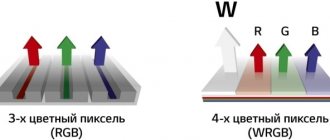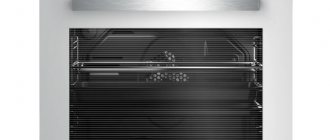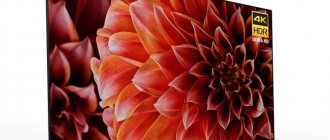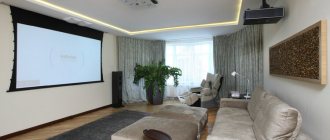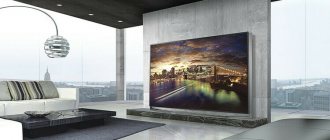Share on social media networks:
The development of technological progress very quickly brings innovations to the modern market. When purchasing a new model of TV equipment, it would not hurt to understand the functional capabilities of this equipment in advance, pay special attention to the features of different manufacturers, decide on an acceptable price, the size of the device and listen to the opinions of experts. In this article we will look at Philips, LGi or Samsung TV - which is better. To do this, we will perform a detailed analysis of companies and their products according to the most important characteristics.
How to choose a TV?
To correctly purchase a television device, you must adhere to some recommendations:
- When choosing the screen size, you need to take into account the dimensions of the room in which the TV device will be located. There is unspoken advice - that the distance to the monitor be equal to three screen diagonal sizes.
- It is necessary to accurately determine the technology for the production of television equipment, since each type has both positive and negative sides. Today, liquid crystal technology is the most widespread and in demand.
- For convenient viewing, you need to select the correct screen resolution.
- You need to decide on a brand. This choice is most often determined by personal preferences for the country of manufacture, the brand model, and sometimes even the design. For some, this preference does not make common sense. However, the question, “Philips” or “Samsung” TV - which is better, arises quite often.
- It is necessary to choose a brick-and-mortar store because a TV that meets your requirements should definitely be inspected before purchasing. Choosing an online store is not the best option.
- You need to look at the picture correctly. When choosing a TV device, you need to ask the store consultant for the remote control. All models in stores on demonstration stands are configured in such a way as to create an improved picture. The picture needs to be viewed in factory settings to really understand the functionality of the proposed model.
- You need to be able to listen to sound correctly. A television device means not only viewing a screen image, but also listening to audio messages. The bass sound should be low, even a little rumbling. Even at full volume and the maximum bass point, no rattling should be felt.
- It is necessary to correctly perceive information from store consultants. In addition to customizing the image on the demo stand, sellers throw out a lot of information consisting of a waterfall of incomprehensible terms and numerical parameters. Even for branded manufacturers, the declared parameters are relative, since there are a lot of methods that measure contrast, brightness and other indicators.
Which TV to choose and which is better - Samsung or Philips?
To decide which TV is better - Samsung or Philips, you need to consider the positive and negative characteristics of each brand.
Important! The digital technology market today represents many worthy brands. Our separate review will help you figure out “Which TV is better - Samsung or Sony?”
Fast scene smoothing
Since 2013, Samsung TV devices have the same 100 HZ fast scene smoothing feature as Philips TV equipment. This means that a similar indicator is characteristic of both brands.
But there is still a slight difference. Samsung TV LCDs use a faster response rate.
Important! If we conduct a comparative analysis of the quality and clarity of fast picture playback, the Samsung device for watching television shows wins in the budget range.
Important! If you are planning to place your TV on the wall, find out which TV bracket is best on our useful tips portal.
Playing media files from USB drives:
- Reading movies from USB hard drives and flash drives does not cause any problems with the Korean model of the Samsung television device. Any budget model is characterized by supporting any format and reading movies from USB drives.
- The Philips TV viewing device does not support many video formats.
Important! Does your TV not support Smart TV? Do not despair! Even on slightly outdated TV models you can use this functionality. We have prepared a separate article “How to choose a Smart TV set-top box for your TV?”
Tuners
The presence of built-in tuners in budget models of the two brands does not cause any differences. All models of LCD TVs have the following tuner devices: analog, DVB-C, DVB-T(2).
Important! There is no difference in the quality of analog signal processing; if you look at it, “Philips” or “Samsung” - which is better? Follow the link and find out in our special post “Digital tuner for TV - what is it?”
LCD matrices
The liquid crystal matrix used serves as a fundamental component, which determines 70 percent of the price factor. It is this matrix that plays a significant role for:
- picture reproduction quality;
- static contrast;
- color rendering and viewing angles.
Based on this criterion, you can decide whether “Philips” or “Samsung” is better:
- A Samsung television device uses S-PVA matrices, which are manufactured by the company itself. Such matrices are characterized by good brightness and high static contrast. Color rendition is not entirely natural, but quite decent for budget TV models. The S-PVA LCD matrix is characterized by the presence of deep black color and low response.
- Philips television devices use matrices from LG. Types of S-IPS matrices used. These types have lower contrast and are not as good at reproducing fast pictures, but the color rendition is more natural.
Important! Are you planning to add satellite TV to your new TV? We have collected all the useful information in the post “Which dish to choose for your TV?”
Design:
- Samsung TVs are distinguished by their elegant, sophisticated design. Budget models have a thickness not exceeding 4.6 cm.
- Budget television devices from Philips are characterized by the presence of thicker models.
Important! Each person has their own preferences. For some people, Philips television devices are attractive in design, while other users prefer the interesting design of Samsung.
Advantages and disadvantages
Let's look at the positive and negative aspects of television devices from two brands to understand which TV is better - Samsung or Philips.
Advantages of budget models from Samsung:
- The devices have a lower cost compared to Philips equipment.
- The ability to support various formats and high-quality playback of films from a hard drive and flash drive.
- The presence of a high degree of contrast and excellent brightness of the LCD matrix.
Advantages and disadvantages of Philips models:
- High-quality color rendition.
- It is not able to support all types of formats, and for some films there is no readability at all.
- Slow response of the main menu to requested functions.
Important! When purchasing new equipment for your home, be sure to take care of high-quality components. On our portal there is a separate article about one such component for a TV, “Coaxial cable for a TV - which one to choose?”
We compare four 65-inch TVs of different price categories
Even if you stop at one screen size and resolution, the cost of TVs can still vary by almost an order of magnitude. Let's try to figure out what exactly the user will get if he buys a TV that is several times more expensive, and what the viewer will lose by choosing a cheaper model. The upper price segment will be represented by two TVs, produced by LG and Samsung. As one of the cheapest TVs available on the Russian market, we chose a model from Harper, and a TV that is a little more expensive, but still closer to the lower segment, is a model from the famous Chinese company Xiaomi.
| Manufacturer and website | Samsung | Xiaomi | Harper | |
| Model (our review) | OLED65C9PLA | QE65Q70RAUXRU | Mi TV 4S 65″ (L65M5-5S) | 65U750TS |
| Price | RUB 179,990* | RUB 179,990* | RUB 47,400** | RUB 36,220** |
| * Official retail price in the company’s online store at the time of preparation of the review. ** Retail price in the online store where the TV was purchased at the time of preparation of the review. | ||||
LG and Samsung TVs can most likely be purchased at retail for a significantly lower price, but it is significant that the manufacturers themselves position them as equally valuable to the consumer.
To illustrate some points, there are demonstration videos in a number of sections. Please take the following notes into account:
- It is impossible to evaluate the color balance from video, since it is impossible to set the color balance on the camera for simultaneous shooting of different TVs, and even with different image output technologies.
- The table surface is reflected at the bottom of the screens, please take this into account when comparing.
Design and ergonomics
Evaluating design is very subjective, but let's try to do it anyway. We will award first place for design in this four to LG TV. It features a very thin edge-to-edge screen with very narrow bezels. When viewed from the front, the screen appears to float in the air. The rear view (for a TV this is not very important, but still) is slightly worsened by the massive and far-out counterweight (which also very significantly increases the weight of the TV). And from the point of view of convenience (that is, ergonomics), in the case of wall mounting, the negative aspects include a closed niche with rear-facing connectors.
Second place for Samsung. A conventionally frameless screen, but with a more massive border. A relatively thin body, a neat rear view, conveniently located interface connectors, a cable management system (the last two points are a plus for ergonomics), but still very trivial legs (a minus for the design). Overall good, but nothing eye-catching.
The second and third places in the design rating were shared by the two remaining TVs. Both have a relatively thick body and simple legs with a tick, but Harper’s legs are at least made of aluminum alloy, not like Xiaomi’s flimsy plastic ones, which barely provide it with any stability. Both TVs have thick frames by modern standards. Yes, Xiaomi has steel frames, but for some reason they were simply polished, which is why they glare and distract the viewer (minus for ergonomics).
The Harper frame is simply plastic, and even mirror-smooth. It seems that black mirror-smooth plastic disappeared a decade or more ago, but here it is still found.
From the back, the Xiaomi looks a little neater than the Harper, but the cramped, enclosed slot with connectors deserves a lower score for ergonomics.
At least the Harper TV has somewhere to route the cables without bending them at the connectors, and you can somehow get to all the connectors when mounting them on the wall (a plus for ergonomics).
Wired Interfaces
With wired interfaces, all four TVs are more or less similar - 3-4 HDMI, 2-3 USB 2.0, digital audio output, inputs for satellite and terrestrial/cable TV, Ethernet at 100 Mbit/s. Analog interfaces, except for the headphone output, can be ignored. Let's list the features. LG has the maximum number of HDMI (4 pieces, and also version 2.1) and USB (3), there is a headphone output, but the value is reduced due to the inconvenient placement of a number of connectors.
Samsung - no headphone output.
Xiaomi - there is no output for headphones or satellite TV, and the antenna input for terrestrial TV is practically useless, since there is no support for DVB-T2/DVB-C.
Harper - USB ports are a little cramped, but otherwise everything is typical.
LG - 1st place, Samsung - 2nd, Harper - 3rd, Xiaomi - 4th.
Wireless interfaces
Let's summarize the data in a table:
| Manufacturer | LG | Samsung | Xiaomi | Harper |
| Model | OLED65C9PLA | QE65Q70RAUXRU | Mi TV 4S 65″ (L65M5-5S) | 65U750TS |
| WiFi | 2.4 GHz and 5 GHz | 2.4 GHz and 5 GHz | 2.4 GHz and 5 GHz | 2.4 GHz |
| Wi-Fi speed* | 866.7 Mbit/s | 866.7 Mbit/s | 433.3 Mbit/s | 72.2 Mbit/s |
| Bluetooth | remote control, sound output from TV and to TV, | remote control, TV audio output, mouse, keyboard, game controllers | remote control, TV sound output, mouse, keyboard | No |
| * When connected to an Asus RT-AC68U router in the 5 GHz band (or 2.4 GHz if there is no 5 GHz). | ||||
How important a fast wireless connection to the Internet is for a smart TV is probably not worth discussing. In urban environments, the presence of the 5 GHz band is a significant advantage, since in this range it is still easier to achieve a stable connection with your router. Bluetooth is important primarily as an interface for connecting headphones. Also, a remote control that works via Bluetooth is much more convenient to use. And as an additional, but still secondary function of Bluetooth, it is the connection of additional input devices. First place will be shared by LG and Samsung, second by Xiaomi, and third by a wide margin by Harper.
Remote control
Main characteristics of remote controls:
| Manufacturer | LG | Samsung | Xiaomi | Harper |
| Model | OLED65C9PLA | QE65Q70RAUXRU | Mi TV 4S 65″ (L65M5-5S) | 65U750TS |
| Interface | IR and Bluetooth | IR and Bluetooth | Bluetooth | IR |
| Number of buttons* | 39 + scroll wheel | 18 | 12 | 45 |
| Coordinate input | There is | No | No | No |
| Voice input | There is | There is | There is** | No |
| Management of third-party equipment | There is | There is | No | No |
| * Based on the number of activations in different positions and excluding functions caused by a long press. ** Useless for Russian users. | ||||
The first place, significantly ahead of its competitors, goes to LG.
The remote control (model AN-MR19BA) is very convenient and functional. It has the optimal number of buttons (not too many and not too few), some of the buttons have second functions called by a long press, 8 digital buttons can be assigned to quickly switch to an input, TV channel or application. The remote control fits comfortably in the hand, works mainly via Bluetooth, is equipped with a microphone and, most importantly, has a gyroscopic mouse function. Also, don't forget about the scroll wheel. This advanced functionality of the remote control greatly improves the usability of working with the TV interface and reduces the need to use external input devices such as a mouse and keyboard. Yes, and keyboards, since the remote's gyroscopic mouse makes typing using the on-screen keyboard much easier.
Second place is the Samsung TV remote control.
The remote control is also very advanced in functionality and fits comfortably in the hand, but there is no coordinate input and there are too few buttons; context menus partially help out, but in general it requires too many actions to call up frequently used functions.
Unfortunately, voice search/input in the case of this Chinese Xiaomi TV model is useless for a Russian user. The only advantage is that it works via Bluetooth.
The Harper TV remote works only via IR and is inconvenient to use, in particular because there are too many buttons, some of which are located too closely.
In total, fourth place is shared by Xiaomi and Harper TV remotes.
Sound
Main characteristics and test results:
| Manufacturer | LG | Samsung | Xiaomi | Harper |
| Model | OLED65C9PLA | QE65Q70RAUXRU | Mi TV 4S 65″ (L65M5-5S) | 65U750TS |
| Speaker type and power | 2.2 ((10 W + 10 W)×2) | 2.1 (40 W RMS) | 2.0 (8 W) | 2.0 (8 W) |
| Quality of built-in acoustics | excellent | excellent | average | below the average |
| Headphone output quality | good | — | — | below the average |
The speaker systems of LG and Samsung TVs win by a huge margin in this comparison. Their sound is clear, loud, with a wide range of reproduced frequencies. The only thing missing is the lowest frequencies, which would be useful for transmitting special effects. For illustration, we present the frequency response obtained by spectral analysis of pink noise using an Octava-110A-Eco sound level meter (absolute values in this case should not be compared, since equality of testing conditions was not observed):
You can see how much more low frequencies LG and Samsung TVs have. Also, the frequency response graphs of these TVs are more or less smooth, without significant dips and peaks. Note that, despite comparable quality, we subjectively liked the sound of the Samsung TV a little more. The sound of the two remaining TVs is not so loud, there are practically no low frequencies, but there are pronounced overtones due to the resonances of the body, while the sound quality of Harper is slightly worse than that of Xiaomi.
Two TVs have a headphone output; the LG has noticeably better sound in the headphones than the Harper.
The difference in the quality of built-in acoustics can be appreciated by watching the video below. The built-in microphone of a Panasonic AG-DVX200 video camera was used to record sound. Despite the conventionality of such a comparison, the difference is clearly audible.
The video in original quality can be viewed at iXBT.video
TV tuner
Let us indicate the features of receiving TV programs in the case of DVB-T2 terrestrial television:
| Manufacturer | LG | Samsung | Xiaomi | Harper |
| Model | OLED65C9PLA | QE65Q70RAUXRU | Mi TV 4S 65″ (L65M5-5S) | 65U750TS |
| Reception quality | high | high | — | high |
| Record | No | There is | — | There is |
First place for Samsung. Samsung's TV reception and recording features are easy to use, and even with the default settings, low-resolution images are improved to the point where they no longer look too bad on a large, high-resolution screen. Harper TV deserves second place, but only because of the recording function, watching over-the-air TV is still better on LG. Xiaomi takes last place in this comparison due to the lack of a DVB-T2 tuner.
Video playback quality
Maximum bitrate when playing test video files with 4K resolution (H.264, https://jell.yfish.us/) from USB drives and over the network:
| Manufacturer | LG | Samsung | Xiaomi | Harper |
| Model | OLED65C9PLA | QE65Q70RAUXRU | Mi TV 4S 65″ (L65M5-5S) | 65U750TS |
| USB | 250 Mbit/s | 200 Mbit/s | 120 Mbit/s | 140 Mbit/s |
| WiFi | 200 Mbit/s | 200 Mbit/s | 110 Mbit/s | 35 Mbit/s |
| Ethernet | 90 Mbit/s | 90 Mbit/s | 90 Mbit/s | 50 Mbit/s |
It cannot be argued that any of the four TVs compared deserves the title of an impeccable and omnivorous multimedia player. A modern PC is still better in this regard. Choosing the best of the four, we will focus on LG. It is on this TV that you will most likely be able to easily watch modern video files with resolutions up to 4K, frame rates up to 60 fps and in HDR mode. In second place is Samsung. Secondly, there are two features - DTS tracks are not supported and HDR MKV files with HDR10 and WebM are output with pale colors, that is, in SDR mode.
Only nominal support for HDR output in the case of Xiaomi and Harper TVs does not allow them to be considered as means for outputting HDR content. In addition, Xiaomi does not support the VP9 codec, which, in particular, leads to problems with playing WebM streams from YouTube. Harper TV does not support hardware decoding of DTS and WMA audio tracks, but they can be played in third-party programs in software decoding mode. As a result, these two TVs fall into last place.
Features of video output
Adjusting the screen refresh rate to the frame rate (via a fraction: in the video file/in the video signal):
| Manufacturer | LG | Samsung | Xiaomi | Harper |
| Model | OLED65C9PLA | QE65Q70RAUXRU | Mi TV 4S 65″ (L65M5-5S) | 65U750TS |
| 24 fps | is/is | is/is | no (60 Hz)/no (50 Hz) | no (60 Hz)/no (60 Hz) |
| 25/30/50/60 fps | is/is | is/is | no (60 Hz)/yes | no (60 Hz)/no (60 Hz) |
LG and Samsung take first place. Xiaomi has the latter, since 24 fps video looks better with a refresh rate of 60 Hz (as in Harper) rather than 50 Hz.
Reduced color clarity when connected to a PC and an RGB signal:
| Manufacturer | LG | Samsung | Xiaomi | Harper |
| Model | OLED65C9PLA | QE65Q70RAUXRU | Mi TV 4S 65″ (L65M5-5S) | 65U750TS |
| Horizontally | is decreasing | does not decrease* | does not decrease | decreases** |
| Vertically | does not decrease | does not decrease* | does not decrease | decreases** |
| *A specific combination of settings is required. **Due to the characteristics of the LCD matrix | ||||
The reduction in color clarity primarily determines how comfortable it will be to use the TV as a large monitor for a PC. The first place is shared by Samsung and Xiaomi, the second by LG, and the third by Harper.
With Xiaomi, a decrease in color clarity can be avoided (please take into account the difficulties of photographing images from the screen, at least moire appears):
At LG, color clarity is not reduced when outputting raster images using the built-in player:
And it decreases slightly horizontally when outputting an image from an external video source (red vertical stripes are not as saturated as horizontal ones, and green vertical stripes are slightly blurred).
If you view the image from a fairly close distance, the quality of the image will be affected by the structural features of the matrix. Let's look at microphotographs (the scale varies):
LG: green subpixel - between red and blue
Samsung
Xiaomi
Harper
LG's pixel consists of a red, green, blue and white subpixel, Samsung and Xiaomi have a red, green and blue subpixel, and Harper's has one pixel made up of a red, green and blue subpixel, and every other pixel consists of only a white subpixel . As a result, at the distance from the screen at which 4K resolution is useful, the picture on this TV looks “loose.” An example is shown in the screen photograph below (stripes through a pixel and through two pixels), it is best viewed on a scale of 1:1 (
).
In the case of Xiaomi and Harper, dynamic color mixing is precisely used to display all shade gradations. This can be seen close up in halftones with slow eye movement. Therefore, in terms of picture quality at close range, LG and Samsung will take first place, Xiaomi will take second place, and Harper will take third place by a wide margin.
One of the most requested features is the tween insertion feature, so it's also worth checking out. LG and Samsung have it and its quality is very good, Xiaomi and Harper do not.
Gaming Features
To achieve high results, as well as for a pleasing image in the case of dynamic games, support for high refresh rate and variable refresh rate (VRR) modes, low response times and output lags are important. Let's put it all in a table:
| Manufacturer | LG | Samsung | Xiaomi | Harper |
| Model | OLED65C9PLA | QE65Q70RAUXRU | Mi TV 4S 65″ (L65M5-5S) | 65U750TS |
| 120Hz mode | 2560×1440 and below* | 2560×1440 and below* | No | No |
| VRR support | yes, G-Sync Compatible** | yes, AMD FreeSync | No | No |
| Response time*** | 4.2ms (4.2ms) | 16 ms (11 ms) | 22 ms (26 ms) | 23 ms (29 ms) |
| Output Latency, 4K/60Hz | 15 ms | 20 ms | 50 ms | 23 ms |
| Output Latency, FHD/120 Hz | 6 ms | 7 ms | — | — |
| * Perhaps there is support for 120 Hz in the case of 3840x2160. ** On video cards of the GeForce GTX 16xx and RTX 20xx family. *** Total black-white-black (and between halftones in total). | ||||
First place in games goes to LG. Second is Samsung. Still, the response time of Samsung is significantly longer, and the matrix is overclocked, which can lead to visible artifacts. Third - Harper. And lastly, Xiaomi due to too much output lag.
Contrast and Brightness
| Manufacturer | LG | Samsung | Xiaomi | Harper |
| Model | OLED65C9PLA | QE65Q70RAUXRU | Mi TV 4S 65″ (L65M5-5S) | 65U750TS |
| White Uniformity | Great | Fine | average | average |
| Black Uniformity | perfect | not determined | Fine | Fine |
| Contrast | not applicable | 3600:1 | 1020:1 | 950:1 |
| Maximum brightness | 332 cd/m²* | 446 cd/m² | 327 cd/m² | 324 cd/m² |
| Minimum brightness | 51 cd/m²* | 31 cd/m² | 90 cd/m² | 21 cd/m² |
| * On a white area of 25% of the screen area on a black background. SDR mode. | ||||
In the OLED matrix that is installed in this LG TV, each subpixel is an independently controlled light source. That is, each subpixel can glow at maximum brightness, while any adjacent subpixel can remain completely black. As a result, in the case of LG TV, absolute black color is achieved and the concept of contrast is no longer applicable. Also, due to the absence of layers that provide matrix illumination, LG’s white uniformity across the screen area is excellent.
The Samsung TV model in question is equipped with direct multi-zone LED backlighting. This allows you to locally highlight bright areas of the image and darken dark ones, thereby improving image contrast. Since there are many times fewer backlight LEDs than there are pixels in the matrix, each LED illuminates an area of tens, if not hundreds, of pixels. Because of this, in some types of images you can see artifacts in the form of local flare around or near bright objects. For example, in the case of a test image with stripes of white dots:
However, the TV processor tends to greatly reduce the brightness of the backlight under small bright objects, and even turn off the backlight if there are very few point bright objects, so the halo is almost never visible in real images. Even frames that are just dark on average in area are greatly darkened. This constant adjustment of brightness can be slightly annoying and reduce the perceived image quality in scenes with variable lightness. It is simply impossible to disable this adjustment, which, in particular, does not allow you to visually assess the actual uniformity of the black field.
Xiaomi and Harper TVs are equipped with IPS matrices with a contrast typical for this type of matrix, but still the black color, especially in a darkened room, on the screen of these TVs is perceived rather as dark gray, however, there are no special complaints about the uniformity of black. The white uniformity across the screen area of these TVs is average.
In the case of all four TVs, the white brightness is sufficient so that the image does not seem dim in a brightly lit room (the exception is the full-screen white field on LG). For conditions of complete darkness, all TVs except Xiaomi can reduce the brightness to a comfortable level. However, this is a very conditional statement, since the screens of these TVs are large, they are highly likely to occupy a large area of the viewer’s field of view, and therefore, even in the dark, they can be brighter without causing fatigue to the viewer.
The video below demonstrates how bright spots disappear on a Samsung TV and the brightness decreases in dark scenes, and vice versa, how the brightness of very light scenes decreases on an LG TV. In the same video you can evaluate the unevenness of the backlight across the screen area.
The video in original quality can be viewed at iXBT.video
Anti-glare properties
In viewing conditions where there may be reflections on the screen, visible contrast can improve the anti-glare properties of the screen. In this case, the LG TV clearly has them - the brightness of objects reflected in the screen of this TV is significantly reduced. There is also some slight reduction in the case of Harper TV, while the screens of Samsung and Xiaomi TVs do not have pronounced anti-glare properties.
Anti-glare properties can be assessed in the video below, in which two identical lamps are reflected in the screens of two TVs.
The video in original quality can be viewed at iXBT.video
Flicker
Fatigue from watching TV for long periods of time can increase screen flicker that is directly visible or detectable in some situations.
| Manufacturer | LG | Samsung | Xiaomi | Harper |
| Model | OLED65C9PLA | QE65Q70RAUXRU | Mi TV 4S 65″ (L65M5-5S) | 65U750TS |
| Flicker | absent | zone PWM 120 Hz or 960 Hz | PWM 300 Hz | absent |
With flickering, everything is clear in the case of LG and Harper - it is not there. With Samsung, flickering in most modes can be detected with rapid eye movement or in a simple test for the stroboscopic effect, but due to the distribution of the modulation phase over the screen area, this flickering does not cause any particular discomfort. And if you turn on the Cinema mode and turn off the insertion of intermediate frames, the Samsung PWM frequency increases to 960 Hz, which from a practical point of view completely eliminates the flickering effect. In the case of Xiaomi, the modulation frequency is relatively high, flickering in principle cannot be detected during normal TV viewing, but still at medium and low brightness with rapid eye movement or in the stroboscopic effect test, image flickering can be detected. It turns out that according to the criterion of flicker visibility, LG and Harper take first place, Samsung is second (albeit with reservations), and Xiaomi is third.
In the video below, the demonstration of flickering on a Samsung screen is very conditional, since the eye, unlike the camera, does not see flickering in the case of PWM with a frequency of 120 Hz, but flickering is detected in the stroboscopic effect test and, in some cases, with rapid eye movement.
The video in original quality can be viewed at iXBT.video
HDR support
The output quality of HDR content depends on four key parameters: peak brightness, color gamut (you want at least a good approximation of DCI gamut), 10-bit color output quality, and contrast. Contrast was discussed above, let's bring the first three parameters into the table:
| Manufacturer | LG | Samsung | Xiaomi | Harper |
| Model | OLED65C9PLA | QE65Q70RAUXRU | Mi TV 4S 65″ (L65M5-5S) | 65U750TS |
| Peak brightness, 10% white | 840 cd/m² | 813 cd/m² | 327 cd/m² | 324 cd/m² |
| Peak brightness, 100% white | 155 cd/m² | 456 cd/m² | 327 cd/m² | 324 cd/m² |
| Color gamut | very close to DCI | very close to DCI | very close to sRGB | very close to sRGB |
| 10-bit color output | Fine | Very good | Fine | Fine |
Real HDR support can only be discussed in the case of LG and Samsung TVs. Xiaomi and Harper have low peak brightness, narrow color gamut for HDR and low contrast. LG has low brightness when outputting a white field, but in the case of real content, something close to a white field in the entire screen happens very, very rarely. As a result, taking into account the ideal contrast of LG and the brightness control features of Samsung, in the vast majority of cases, the output of an HDR image will be better in LG. Second place with a small margin goes to Samsung. Xiaomi and Harper lost outright.
The video demonstrates how HDR video from YouTube is displayed on TV screens:
The video in original quality can be viewed at iXBT.video
Brightness balance
Let's evaluate the accuracy of the gamma curve, the number of output shades on the gray scale with an 8-bit color representation, and the discernibility of gradations in the shadows.
| Manufacturer | LG | Samsung | Xiaomi | Harper |
| Model | OLED65C9PLA | QE65Q70RAUXRU | Mi TV 4S 65″ (L65M5-5S) | 65U750TS |
| Gamma Curve Accuracy | very high | average | good | average |
| Approximation index | 2,20 | 2,46 | 2,27 | 1,87 |
| Number of shades | All | Almost all | reduced | All |
| Visibility of gradations in shadows | excellent | good | good | good |
LG takes first place - an accurate gamma curve and display of all shades ensure that the brightness balance is not distorted. Second place goes to Samsung and Harper. Third - Xiaomi, since a significant reduction in the output shade gradations can lead to visible artifacts in the form of excessive banding of the gradients.
Color quality
We will evaluate the quality of color rendition from the point of view of the correct display of SDR content. The color gamut should be as close as possible to sRGB, the color temperature should be close to 6500 K, and the deviation from the blackbody spectrum (ΔE parameter) should ideally be below 3, or at least below 10, while ensuring good stability of these parameters over time. most of the gray scale (except for the darkest part).
Color gamut:
LG OLED65C9PLA
Samsung QE65Q70RAUXRU
Xiaomi Mi TV 4S 65″ (L65M5-5S)
Harper 65U750TS
The approximation of coverage to sRGB on LG TV is almost perfect, but on other TVs it is very good. Three TVs come out on top - LG, Xiaomi and Harper - with Samsung taking last place as sRGB color options are not available, such as in PC mode and 60Hz refresh rates.
Colorful temperature:
LG OLED65C9PLA
Samsung QE65Q70RAUXRU
Xiaomi Mi TV 4S 65″ (L65M5-5S)
Harper 65U750TS
The color temperature is more accurate and uniform (even after manual correction) on LG and Xiaomi TVs - this is the first place. The second is for Samsung (on not the darkest shades the color temperature is already rising) and Harper (the color temperature is a bit high).
Deviation from blackbody spectrum (ΔE):
LG OLED65C9PLA
Samsung QE65Q70RAUXRU
Xiaomi Mi TV 4S 65″ (L65M5-5S)
Harper 65U750TS
The first place is still in LG, the second is Harper, the third is Samsung and Xiaomi.
Viewing Angles
Viewing angles are an important characteristic, especially in the case of large TVs, since in most cases the viewer will be close enough to them that the deviation of the view from the perpendicular to the corners of the screen reaches a large value.
First, let's look at how quickly brightness drops when viewed from an angle. Let's compare the average decrease in brightness at an angle of 45 degrees for vertical, horizontal and diagonal deviations. Then we will determine how much the black field is brightened and, finally, we will find out how the colors of the shades change on average, all this also at an angle of 45 degrees.
| Manufacturer | LG | Samsung | Xiaomi | Harper |
| Model | OLED65C9PLA | QE65Q70RAUXRU | Mi TV 4S 65″ (L65M5-5S) | 65U750TS |
| Average white brightness*, %%** | 69 | 23 | 29 | 39 |
| Average black brightness*, %%** | not applicable | cannot be measured | 0,24 | 0,33 |
| Hue shift* | 1,5 | 5,2 | 1,8 | 1,7 |
| * Average value for deviation in three directions at an angle of 45 degrees from perpendicular to the screen. ** Percentage of the brightness of the white field perpendicular to the screen. | ||||
In terms of the speed of brightness decrease at an angle, the first place and by a large margin goes to LG. In second place is Harper, in third is Xiaomi, and last is Samsung; in the case of this TV, the brightness at an angle drops faster than the other three.
With LG, black remains absolutely black, no matter what angle you look at it from. The increase in Samsung's black brightness is very difficult to determine due to the zonal dynamic decrease in backlight brightness (but black is very dark in any case). As a demonstration, here is a photograph of a black field with bright dots in the case of LG and Samsung TVs (on the left - LG, on the right - Samsung).
LG's is completely black, while Samsung's is slightly overexposed, and it's more visible at an angle. In the remaining two, the black at an angle is highlighted more in Harper.
The angular color shift is minimal for LG and maximum for Samsung.
In the video below you can see how the brightness and colors change when viewed at an angle relative to viewing strictly perpendicular to the screen. The brightness of the TVs is set to the same.
The video in original quality can be viewed at iXBT.video
Results
Let's summarize. Of course, it was possible to find many more criteria by which it would be worth comparing TVs, but, perhaps, we’ll make do with what is described above. We understand that any rating with points and a final grade only creates the appearance of some objectivity, since the points and weighting coefficients by which the results are formed are an exclusively subjective choice of those making the comparison. In justification, we can only say that each reader is free to sum it up on his own, using the materials from the full reviews of these four TVs. We came to the following conclusion (scores by category are given):
| Manufacturer | LG | Samsung | Xiaomi | Harper |
| Model | OLED65C9PLA | QE65Q70RAUXRU | Mi TV 4S 65″ (L65M5-5S) | 65U750TS |
| Design | 5 | 4 | 3 | 3 |
| Ergonomics | 4 | 5 | 3 | 4 |
| Wired Interfaces | 5 | 4 | 2 | 3 |
| Wireless interfaces | 5 | 5 | 4 | 2 |
| Remote control | 5 | 3 | 2 | 2 |
| Sound | 5 | 5 | 3 | 2 |
| TV tuner | 3 | 5 | 0 | 4 |
| Video playback quality | 5 | 4 | 2 | 2 |
| Adjusting the screen refresh rate | 5 | 5 | 3 | 2 |
| Reduced color clarity | 4 | 5 | 5 | 2 |
| Inserting Tweaks | 5 | 5 | 0 | 0 |
| Picture quality up close | 5 | 5 | 4 | 2 |
| Quality in games | 5 | 4 | 1 | 2 |
| White Uniformity | 5 | 4 | 3 | 3 |
| Contrast | 5 | 3 | 1 | 1 |
| Brightness range | 5 | 5 | 4 | 5 |
| Anti-glare properties | 5 | 3 | 3 | 4 |
| Flicker | 5 | 4 | 3 | 5 |
| HDR support | 5 | 4 | 1 | 1 |
| Brightness balance | 5 | 4 | 3 | 4 |
| Color gamut (sRGB) | 5 | 4 | 5 | 5 |
| Color temperature (6500 K) | 5 | 4 | 5 | 4 |
| ΔE | 5 | 3 | 3 | 4 |
| Dimming at an angle | 5 | 1 | 2 | 3 |
| Increase in black brightness at an angle | 5 | 4 | 2 | 1 |
| Shift colors by angle | 5 | 2 | 4 | 4 |
| Total | 126 | 104 | 71 | 74 |
The winner was the LG OLED65C9PLA TV, which is distinguished by very good functional equipment and the presence of an OLED matrix with unique properties. This TV is suitable for both watching movies and the most dynamic games. Second place with a significant gap from the winner goes to Samsung QE65Q70RAUXRU TV. This display device also has a wide variety of useful functions, but the LCD matrix, although contrasty and with zonal backlighting, is still inferior to the OLED matrix in terms of image quality. Also, the rating was partially reduced due to the too complex dependence of the image properties on the combination of settings. The two remaining TVs occupy third place. They are inferior to the two leaders in many respects, such as the level of HDR support and gaming capabilities. We hope that we were able to clearly show why the cost of TVs can vary significantly, as well as what the viewer gets by paying more, and what they lose by saving.
Mid-price range and higher-end models
Branded television devices from Philips and Samsung demonstrate more functional Smart TV and 3D models that have a stylish and sophisticated design. The S-IPS matrix from LG serves as a fundamental element for the model range up to the 7th edition of Philips. Samsung uses S-PVA matrices, which are its own developments.
Important! If you try to conduct a comparative analysis of image quality between television devices from leading companies, it is definitely difficult to determine the superiority of one model over another.
Each branded model has some disadvantages. For example, Philips television devices, even models with 400 Hz PMR functionality, while trying to reproduce fast pictures, are not able to achieve the required degree of clarity and sharpness of the moving image. The reason for this shortcoming, most likely, lies in the characteristic feature of the IPS matrix, which is characterized by a high response (6-8 ms), poor quality display of fast scenes and a static contrast in the range of 200:1.
Smart TV
Which TV is better - Samsung or Philips? Samsung supplies the modern market with optimal solutions from the best smart TV designs. This option is characterized by:
- convenient menu;
- the presence of a full-fledged browser;
- the ability to connect wireless elements such as a mouse and keyboard.
Important! Smart TV Samsung is a very fast menu response, the ability to download and install various applications and everyone’s favorite games for free. All applications are characterized by the presence of a Russian version, since they are mainly developed for the CIS market.
The Samsung Smart TV model is to some extent reminiscent of a computer, unlike the Philips Smart TV model, which has many problematic issues:
- Not every Smart TV model from Philips is equipped with a full-fledged service. For example, the PFL 3507 model is characterized only by the ability to access the YouTube service, in which you can only watch streaming videos.
- A similar model Samsung EH5300 – Smart TV has all the necessary possible functions.
Important! The Smart TV model from Philips has a much smaller number of different service programs for watching videos online. Additionally, there are no additional app options. Therefore, in this parameter, Samsung clearly has a clear advantage.
3D functional feature
Samsung TVs use active 3D technology. Philips also has active 3D in the PFL5 version, and the polarization type of passive 3D is used in the PFL6 version.
When comparing active 3D from Philips and Samsung, there is no significant difference in quality. For two branded models, the same conditions apply to create a 3D image. But since Samsung television devices have higher brightness parameters, viewing a 3D image is accompanied by an imperceptible deviation in brightness and contrast.
Important! If we consider the models of the Dutch company Philips, we can highlight a positive point - the ability to choose various 3D technologies. In addition, the PFL6 series of television devices use the Ambilight technological process. Modern technological process, depending on color reproduction, allows the TV device to be illuminated on both sides with LED elements, which contributes to the visual impact of the 3D picture.
All Samsung models from 40 inches are equipped with 3D glasses. For some branded 32-inch models, this equipment is also available. Philips TV devices come with 3D glasses only from version 6.
Tuners
For the Philips model range, only digital and analogue devices are used. Such tuners come in two varieties: terrestrial and cable. For Samsung TV, starting with the ES6307 model range, there are modern satellite tuner devices.
Advantages and disadvantages
Summarizing the above parameters, we list the advantages and disadvantages of each brand model in order to understand which TV is better - Samsung or Philips.
Pros and cons of Samsung TV:
- the presence of cheap 3D glasses;
- availability of modern satellite tuners;
- functional and convenient Smart TV option.
Advantages and disadvantages of Philips TV:
- active model technology uses expensive 3D glasses;
- availability of limited Smart TV capabilities;
- The model range allows you to select both active and passive 3D;
- application of Ambilight super technology.
Budget TVs LG
The South Korean manufacturer can offer customers three 43-inch TVs.
1. Model 43UK6200
equipped with HDR10, has a resolution of 3840x2160 and is equipped with a matrix with IPS technology and ideal calibration. The viewing angle is maximum and color reproduction is natural. In the end, we get an excellent picture on the screen.
Smart TV runs webOS and is stable even with 4K content and connected via Wi-Fi. Two speakers with a power of 10 W each provide surround sound. When gaming, the response time is 9 ms. The legs of the “Korean” are small. Therefore, household appliances can easily be dropped on the floor. Main characteristics of TV:
The cost of the TV is almost 23 thousand rubles.
2. UK6450
– the second budget TV from the manufacturer ElG. The set of main characteristics includes:
- 4K resolution;
- HDR 10 support;
- Direct LED backlight;
- Matrix with IPS technology.
There is no real black, but color reproduction with contrast and saturation is simply excellent.
Two speakers with a total power of 20 W provide excellent TV sound, perfectly complementing the detailed picture. There is support for Smart TV. The remote control of the model stands out for its ergonomics. It is possible to replace it with a mouse and keyboard. If there are no problems with watching digital channels, then there are problems with analog ones: the image sharpness is poor and it gives off a yellowish look.
Main characteristics of TV:
The cost of the TV is almost 30 thousand rubles.
3. 43UJ750V
It is considered the manufacturer's best budget TV in terms of price-quality ratio. The model has miniature frames and a durable iron stand. High-quality images are provided by an IPS monitor (resolution 3840x2160) and HDR 10. The screen frequency is 60 Hz.
The remote control has pleasant ergonomics. There is Smart TV. The model also works stably when connected to Wi-Fi. However, TV legs are considered unreliable.
Main characteristics of TV:
The cost of the TV is almost 50 thousand rubles.
Why LED TVs?
When choosing a modern TV device, users want not only to purchase multifunctional modern equipment, but also to buy reliable, high-quality equipment, which is characterized by a reputable manufacturer. In today's market, the most popular and in demand are LED TVs from LG, Samsung and Philips.
Such companies are characterized not only by the quality of their products, but also by the use of the latest technologies. Let's try to figure out why LED TVs are chosen the most.
Advantages of LED TV:
- Presence of high definition and detail reproduction. There is no blurring on the monitor of such a TV device, and the image has good sharpness.
- LED TVs are environmentally friendly, since LED backlighting does not use mercury.
- The LED TV category is characterized by a thin body and elegant design. The production features of this technology contribute to the presence of a relatively thin body.
- Very low electrical energy consumption. Particularly notable for the presence of such quality is TV equipment with the presence of side lighting.
Comparison of LG, Samsung and Philips TVs
To objectively evaluate LED TVs, we will consider one model from each manufacturer in one price segment. Let's conduct a comparative analysis:
- Samsung UE46F5020 at 46″;
- LG 47LA620V at 47″;
- Philips 46PFL4208T at 46″.
This will help you understand which TV is better - Samsung, LG or Philips
Screen format:
- For all branded models, the screen format is the same and is 16:9.
- The resolution is the same and equals 1920×1080.
Important! None of the manufacturers stands out in this regard. But for LG TV devices, a distinctive characteristic feature is the possibility of the presence of a polarizing passive 3D format. For this price range, this criterion is very significant.
Refresh rate setting
This criterion is important for any TV device, despite other functionality. Samsung television equipment is much inferior in this indicator to other branded models.
The refresh rate for Samsung branded TVs is 100Hz, while the other two models operate at 200Hz.
Important! Television devices from Philips and LG have a clearer picture.
Resolution
This indicator is not so important, but can become a priority when choosing a branded model. If we consider the amount of support for formats for connecting to a computer device, then:
- The Philips 46PFL4208T TV is much better with support for possible formats: 1920×1080, 1360×768, 1024×768, 640×480, 800×600;
- This series is completed by the Samsung UE46F5020 TV device, which has only two possible formats: 1920×1080, 640×480.
Interface
Currently, one of the decisive factors in purchasing TV devices is the number of interfaces. The right choice allows you to make the most of the functionality of the purchased equipment.
Important! The undisputed leader is the Philips model 46PFL4208T, which has the following ports and connectors:
- AV;
- SCART;
- Two USB types;
- Ethernet;
- Two types of audio input;
- Component portal;
- Three types of HDMI connectors;
- D-Sub.
The LG brand model is equipped with three USB connectors and four HDMI connectors. But the total number is still less than that of the Philips model.
Sound:
- Among the TV devices under review, the LG 47LA620 is the best model with 24 W audio power.
- Other branded models have a rating that is only 20 W.
Functional abilities
Which TV is better - Samsung, LG or Philips?
- When considering the functionality, Samsung equipment does not have the ability to support Wi-Fi wireless communications and the Smart TV format. In this regard, Samsung television devices are much inferior to other brand companies under consideration.
- Comparing the technical parameters of these models, there is a noticeable lag behind Samsung devices.
The lack of functionality to support the Smart TV function played a fundamental role in the decisive moment. The leader is the branded model LG 47LA620V, which is capable of supporting the 3D format, which at this stage is extremely important and relevant. Philips remains only second in this ranking.
Smart TV Samsung, LG or Philips
Television has long ceased to be just a means for watching your favorite programs; manufacturers are increasingly integrating modern models into the world of information technology. One of the most interesting additional features of the TV is Smart TV.
The term Smart TV comes from the English word smart, which translated into Russian means smart. If previously only premium TV models were equipped with the Smart TV function, now this function is available even in models of the mid-price segment. To view the Smart TV function, the TV user must have access to the Internet, which can be organized via wi-fi or cable through the built-in network card in the TV.
Note All TVs that support the smart TV function have an Internet connection, if there is not one, then the smart one will also be absent.
Most Smart TV applications work stably with a high-speed Internet connection; the minimum Internet speed for viewing content should be at least 5 Mbit/s. The Smart TV content available to the user depends on the manufacturer of the TV, as well as the region in which the device is registered.
Smart TV programs include both free programs and programs available for a fee. Most often, the consumer is offered access to social networking services, such as Facebook, Twitter, watching videos on YouTube, a weather forecast service, a TV program guide, access to Picasa photo albums, games, and animated TV screensavers.
The consumer also has access to a web browser, some pay TV channels, and services for watching movies online, such as Megogo and Zoomby. For convenience, the consumer can install a special program on his smartphone that will allow him to use it as a remote control.
Samsung can be called a trendsetter in the field of Smart TV. This TV manufacturer offers its customers the most comprehensive range of services in the field of Smart TV. The first TVs equipped with this function appeared back in 2007, and every year the manufacturer improves its devices; modern TVs of top models resemble a smartphone and tablet, because equipped with all the functions for full surfing and communication on the Internet.
TV models from LG are catching up with Samsung. This manufacturer also offers its customers a full range of options for surfing the Internet, watching movies and videos.
Philips TVs, known for their reliability, picture quality and matrix, are slightly behind their competitors in the field of Smart TV. This manufacturer offers access to Internet services only through its applications; flash technology is not developed on TVs, so the consumer is limited in viewing content from the Internet, primarily this concerns videos from the youtube service, as well as watching films on resources that are not supported by the manufacturer.
In 2014, the manufacturer equipped premium models with the Android operating system, which allowed access to additional features, incl. to the Google Play store. It should be noted that the use of Smart TV is only gaining momentum, most likely in the future we will see expanded capabilities of this service. Of course, there will be skeptics who will point to the fact that most of the capabilities of Smart TV are available thanks to blu-ray players, and on a TV, the image quality is primarily important, not Internet content, so you should not focus on the capabilities of Smart TV. But competition between manufacturers is growing, so in the near future we can expect the most daring solutions in the field of Smart TV.
Video material
Therefore, when choosing a television device, you need to carefully study the technical parameters and read the reviews of competent people to prevent possible errors. And now you know how to deal with this and which is better - Philips or Samsung.
